News Release
"Crystal Laboratory" Research Facility Opens.
July 11, 2005
July 11, 2005
"Crystal Laboratory" Research Facility Opens.
State-of-the-art R&D Space Innovates for Satake and Customers
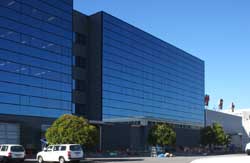 Exterior of Crystal Laboratory |
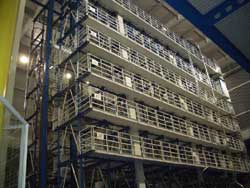 Universal Transport System |
A new R&D space called "Crystal Laboratory" has been completed and opened in the Hiroshima Head Office of Satake Corporation.
The Crystal Laboratory is a new style of R&D space where both customers and Satake can realize their dreams. It is a space where customers can use their five senses to learn about the foods in their life and discover new value. It is a place where all Satake employees will continue to create new value in the relationship between people and food. The main R&D theme behind this space is enhancing the safety, security, taste and healthfulness of foods. Two sub-concepts are "Be gentle to living grains and humans" and "Change grain transport from conventional continuous conveyers to a discontinuous batch conveying method."
The "Universal Transport System" developed under this concept consists of a scaffold and machines arranged three-dimensionally. Each batch of grain is delivered to its intended destination in a container with a maximum 1 ton capacity. It is then processed by the machinery and placed back in a box for delivery to the next process. The system eliminates the risk of contamination by foreign materials or other grains or varieties and minimizes the damage to grains caused by transportation. The Universal Transport System consists of 4 sections: (1) a drying and husking section, (2) a milling and grading section, (3) an IH cooking section, and (4) a section for secondary processing, such as packed rice production system.
The Crystal Laboratory features several specialty laboratories which specialize in processes such as bio-sensing and DNA identification. These specialty laboratories are engaged in highly advanced research and development. The building also features a "Satake History Museum" where visitors can witness 110 years of Satake’s history in an afternoon. The Crystal Laboratory will be open to the public from time to time; children in elementary and middle school will be periodically invited to tour the laboratory and attend rice schools.
Details of the Crystal Laboratory
1. Outline
Groundbreaking : February 2004
Completion : July 2005
Total Construction Cost : 1.3 billion Yen
Dimensions : 5 floors, including a basement floor
Total floor area : 3,200m2
Roof height : 22m
Main Test Facility : 1,000m2
Total area of specialty laboratories: 600m2
Area for Satake History Museum : 200m2
2. Universal Transport System and Secondary Processing facility.
Outline
In conventional rice mills, machines are arranged horizontally and grain is transported by bucket elevators and flow conveyors. The Universal Transport System arranges machines vertically and automatically delivers grains to each machine in a container. This eliminates the risk of material contamination and minimizes damage to grain.
Section Outlines
(1) Drying and Husking Section : Grain Intake, Pre-cleaner, Weighers, Container Dryers, Paddy Husker and Separator, and Thickness Grader.
(2) Milling and Grading Section : Blending machines, Rice Milling Machines, Sifter, Rinse-Free Rice Production System, Weighers and Packers.
(3) IH Cooking Section : Arm-Rack Cooking System (Feeding, Water Adding, Soaking, Seasoning, Cooking, Steaming, Loosening, and Cleaning)
(4) Secondary Processing (Packed Rice Production) Section
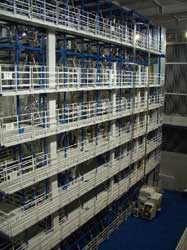 |
[Features of Universal Transport System]
1. Simple steel frame brace structure reduces construction costs.
2. Flexible production improves productivity: because grain is contained in boxes, small lots and frequent changeovers are possible.
3. Because grain is transported in a sealed box, the conveying method neither damages nor dries product, leading to better quality.
4. Electricity usage for conveyors, dust collectors, and pneumatic systems is reduced, lowering operating costs.
5. Safety, Security, Taste and Health. The Universal Transport System provides safety and security to consumers because the box conveyance systems prevents contamination of products. The shelf storage system, common in the logistics industry, makes it easy to trace the processing history of boxed grain. Deterioration of quality and taste of rice is minimized by gentle grain transport, a shorter storage life in the mill, and optimum temperature control.
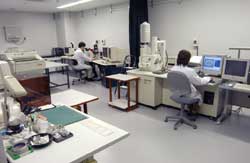 |
3. Laboratory Outlines
DNA Identification (1F, 2F) : Accurately identifies rice variety using DNA.
Chemical Construction Analysis (1F) : Uses a scientific approach to analyze the taste of grains.
Micro Morphology Analysis (1F) : Analyzes microstructure of grains.
Chemical Analysis (2F) : Researches new taste evaluation methods for rice that use sensor technology to approximate human sensory assessment.
Bio-Sensing (2F) : Develops inspection equipment that applies biotechnology to ensure food safety and security.
Grain Characteristics Analysis (2F) : Collects fundamental data to develop remote sensing and photoanalysis for grain components.
Food Physicality Measurement and Processing (3F) : Analyzes grain characteristics, impurity characteristics and rice taste.
Food Chemical Analysis (3F) : Uses chemical analysis to determine palatability of food.
Microbial Analysis (3F) : Suggests methods for quality and hygiene control through microbial inspections, HACCP, sterilizing technology and environmental analysis.
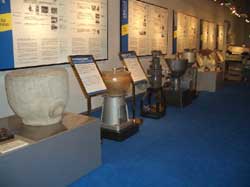 |
4. Satake History Museum
Objective : To pass on the history of Satake and the achievements of over a century of successive managers and leaders. Opened to commemorate Satake’s upcoming company’s 110th anniversary (March 3rd, 2006)
Showpieces : 20 Milestone Products, Satake Chronological Chart, Old Products Leaflets, Biography of Successive Leaders, Oil-Painted Posters by Toshihiko Satake.
Objectives : To deepen the understanding of rice among the public, including children in elementary and middle school, through laboratory tours and education (rice school).
Opening Schedule : Once in a Week starting from August 2005
Laboratory Tour Course : A 2 hour course for the general public and a 1.5 hour course for children in elementary and middle school.
* Please note descriptions in news releases are accurate as of the date of release and may differ from the most up-to-date information.
